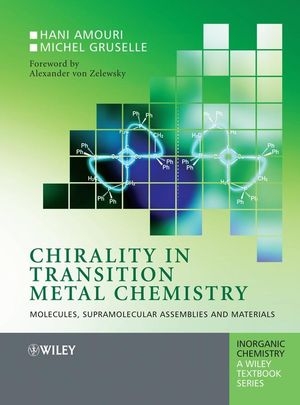
Chirality in Transition Metal Chemistry
John Wiley & Sons Inc (Verlag)
978-0-470-06053-7 (ISBN)
- Titel z.Zt. nicht lieferbar
- Versandkostenfrei
- Auch auf Rechnung
- Artikel merken
Chirality in Transition Metal Chemistry is an essential introduction to this increasingly important field for students and researchers in inorganic chemistry. Emphasising applications and real-world examples, the book begins with an overview of chirality, with a discussion of absolute configurations and system descriptors, physical properties of enantiomers, and principles of resolution and preparation of enantiomers. The subsequent chapters deal with the the specifics of chirality as it applies to transition metals.
Some reviews of Chirality in Transition Metal Chemistry
"...useful to students taking an advanced undergraduate course and particularly to postgraduates and academics undertaking research in the areas of chiral inorganic supramolecular complexes and materials." Chemistry World, August 2009
"... the book offers an extremely exciting new addition to the study of inorganic chemistry, and should be compulsory reading for students entering their final year of undergraduate studies or starting a Ph.D. in structural inorganic chemistry."
Applied Organometallic Chemistry Volume 23, Issue 5, May 2009
"... In conclusion the book gives a wonderful overview of the topic. It is helpful for anyone entering the field through systematic and detailed introduction of basic information. It was time to publish a new and topical text book covering the important aspect of coordination chemistry. It builds bridges between Inorganic, organic and supramolecular chemistry. I can recommend the book to everybody who is interested in the chemistry of chiral coordination compounds."
Angew. chem. Volume 48, Issue, April 2009
About the Series
Chirality in Transition Metal Chemistry is the latest addition to the Wiley Inorganic Chemistry Advanced Textbook series. This series reflects the pivotal role of modern inorganic and physical chemistry in a whole range of emerging areas such as materials chemistry, green chemistry and bioinorganic chemistry, as well as providing a solid grounding in established areas such as solid state chemistry, coordination chemistry, main group chemistry and physical inorganic chemistry.
Haniel Amouri, was born in Anapolis Goias (Brazil) and obtained his Ph.D. degree (1987) in chemistry from Universite Louis Pasteur Strasbourg (France), with Professor John A. Osborn, on the subject of homogeneous catalysis (hydrogenation). In 1988 he spent one year at Gif-sur-Yvette (France) as a post-doctoral fellow with Dr Hugh Felkin where he studied C-H activation of saturated hydrocarbon with transition metal polyhydrides. In 1992-1993 he spent one year at UC-Berkeley (USA) with Professor K. Peter C. Vollhardt and was working on the synthesis of oligocyclopentadienyl metal complex and their behaviour as electron transfer reagents. He is a Research Director in CNRS and is currently the director of the 'ARC' group (Auto-assemblage, Reconnaissance et Chiralite) of the IPCM at Universite Pierre et Marie Curie Paris-6. His main research interests are chirality, organometallic and coordination chemistry, and he has had over 90 research papers and reviews published in international scientific journals. Michel Gruselle was born in Decazeville (France) and obtained his Ph.D. degree (doctorat d'Etat) in the CNRS laboratory of Thiais, a suburb of Paris, in 1975 with Dr Daniel Lefort where he worked on stereochemical problems in radical chemistry. In 1974 he joined Bianca Tchoubar's group and started working on nitrogen activation by organometallic complexes, and he spent some time collaborating with Prof. A.E. Shilov in Moscow. he is a Research Director in CNRS at Universite Pierre et Marie Curie Paris-6 and was the director of the ARC group (Auto-assemblage, Reconnaissance et Chiralite) at the IPCM from 1996-2000. His main research interests a4re enantioselective synthesis in coordination chemistry and in material science and he has had over 110 research papers and reviews published in international scientific journals.
Foreword by Alex von Zelewsky 1.Introduction
2 Chirality and enantiomers
2.1 Chirality
2.2 Enantiomers and racemic compounds
2.3 Absolute configurations and system descriptors
2.4 Physical properties of enantiomers and racemics
2.5 Principles of resolution and preparation of enantiomers
2.6 Summary
3 Some examples of chiral organometallic complexes and asymmetric catalysis
3.1 Chirality at metal half-sandwich compounds
3.2 Chiral-at-metal complexes in organic synthesis
3.3 Asymmetric catalysis by chiral complexes
4 Chiral recognition in organometallic and coordination compounds
4.2 Chiral recognition using the chiral anion strategy:
4.3 Brief introduction to DNA discrimination by octahedral polypyridyl metal complexes:
5 Chirality in supramolecular coordination compounds
5.1 Self-assembly of chiral polynuclear complexes from achiral building units.
5.2 Chirality transfer in polynuclear complexes: Enantioselective Synthesis
6 Chiral enantiopure molecular materials
6.1 General considerations
6.2 Conductors
6.3 Metallomesogens
6.4 Porous metal-organic coordination networks (MOCN)
6.5 Molecular magnets
6.6 Chiral surfaces
6.7 Summary
| Erscheint lt. Verlag | 1.12.2008 |
|---|---|
| Reihe/Serie | Inorganic Chemistry: A Textbook Series |
| Mitarbeit |
Herausgeber (Serie): J. Derek Woollins, David A. Atwood, Robert H. Crabtree |
| Verlagsort | New York |
| Sprache | englisch |
| Maße | 194 x 253 mm |
| Gewicht | 730 g |
| Themenwelt | Naturwissenschaften ► Chemie ► Anorganische Chemie |
| ISBN-10 | 0-470-06053-0 / 0470060530 |
| ISBN-13 | 978-0-470-06053-7 / 9780470060537 |
| Zustand | Neuware |
| Haben Sie eine Frage zum Produkt? |
aus dem Bereich


